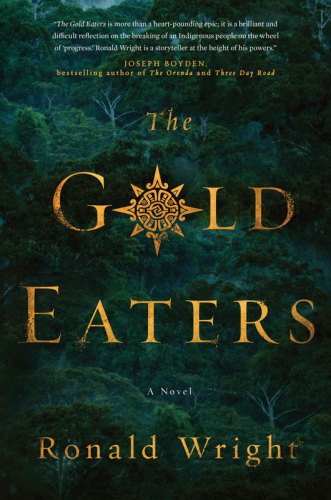
The Gold Eaters
A Novel
کتاب های مرتبط
- اطلاعات
- نقد و بررسی
- دیدگاه کاربران
نقد و بررسی

September 7, 2015
Wright’s (Henderson’s Spear) latest historical novel tackles the complex and tragic story of Spanish explorer Francisco Pizarro and his army of conquistadores, as they ravage and destroy Peru’s Inca civilization in their insatiable hunger for gold during the years 1526–1544. Waman, an adolescent fisherman in northern Peru, is captured at sea by a Spanish ship, revealing “how easily Christians become savages.” Waman is kept as a slave, to be Pizarro’s interpreter, during the expedition. Waman always thinks of escape, though because of his value to Pizarro, he knows it’s nearly impossible. The mighty Incan empire is decimated by Spanish-borne smallpox, and Waman’s family is dispersed in the chaos. Waman accompanies Pizarro to Spain, where the explorer appeals to the King and Queen for more support to return to conquer all of Peru. As years pass Waman witnesses Spanish duplicity, treachery, and brutality with false promises and cannons crushing Incan resistance, inciting an Incan civil war. When hoards of Incan gold and silver are discovered, greed, disease, and infighting among the Spaniards threatens the newest campaign. This is a rousing adventure tale of bold exploration and conquest, but best is Wright’s vivid portrayal of unrestrained 16th-century Spanish imperialism, complete with villains, victims, and a few heroes. Agent: Henry Dunow, Dunow, Carlson & Lerner.

September 1, 2015
Historian Wright's third novel (Henderson's Spear, 2002, etc.) finds a young Inca boy swept into Francisco Pizarro's 16th-century conquest of Peru. A single impulsive act gets young Waman tangled with history: after an argument, he leaves his domineering father and boards a ship, also deserting a blooming romance with his cousin Tika. Fate intervenes when his ship is raided by Spanish pirates led by Pizarro, returning to Europe following an unsuccessful attempt to find the Inca stronghold. Once he fights off smallpox and narrowly survives the trip, Waman is forced to become Pizarro's translator. Pizarro takes his grand designs to the king and queen of Spain, who allow him to launch a conquest of Peru. At first the two sides seem unevenly matched, as the culturally evolved Incas ridicule the Spaniards for their primitive manners, Christian beliefs, and hunger for gold. Yet the Inca Empire is already coming undone when its leadership is usurped by Atawallpa, whose hubris will bring consequences; and the story traces the bloody path to Pizarro's first decisive victory. Waman's service as a Spanish soldier and prisoner calls his loyalties and identity into question as the story leads to his long-desired reunion with Tika. Wright's narrative deftly juggles the elements of historical fiction, war story, and coming-of-age novel.
COPYRIGHT(2015) Kirkus Reviews, ALL RIGHTS RESERVED.

Starred review from October 1, 2015
This epic adventure of conquest, war, and cultural differences begins with the kidnapping of a young Inca fisherman, Waman, by Spanish conquistadors. Waman is then forced to act as translator for the infamous Francisco Pizarro. As he becomes a trusted member of the invasion force, Waman finds himself caught between two contrasting civilizations. Wright's (A Scientific Romance) sweeping novel brings vividly to life the brutal reality of conquest and the toll it takes on invaders and vanquished alike, but it also depicts the culture clash with sympathy for both sides. The author's intimate knowledge of South American history and his sense of the dark changes that arrived in Peru with the Spanish in the 16th century makes his book a primer on what it was like to watch years of greed drain an empire of its lifeblood. The use of a third-person present-tense point of view gives the narrative an immediacy and feeling of constantly building tension. VERDICT Wright displays his mastery of the historical fiction form with this terrific novel that will enlighten anyone interested in the conquest of Peru, the vision of Pizarro, and the fate of native Peruvian culture.--Ron Samul, New London, CT
Copyright 2015 Library Journal, LLC Used with permission.

Starred review from September 15, 2015
With this multifaceted historical novel about sixteenth-century Spanish conquistadors in Peru, Wright, author of Henderson's Spear (2002) and multiple nonfiction works, continues to explore the downfall of ancient societies. Through an Incan boy named Waman, and his coming-of-age adventures, beginning with his capture by Francisco Pizarro, readers are treated to a riveting account of the wealthy, culturally superior Incans and the encroachment of the Spaniards on their civilization. The contrast between the dirty, boorish, gold-hungry barbarians from Spain and the pristine elegance of the Incas is one of the tragic themes emphasized in the book, as is Peru's gradual downfall from disease, political infighting, and misjudgment of its own power and cleverness. Fascinating historical details about using knotted strings as a form of writing, about chewing coca leaves, and about including dead leaders' mummified bodies in meetings to advise the Sapa Inca (sovereign emperor) enrich and lend veracity to the exotic setting. The reputations of Balboa, Pizarro, Almagro, and Cortestheir spread of disease in Latin America, their slaughter of the indigenous peoples, and their sheer greedhave been well documented, but Wright's fictionalized treatment brings those abuses home in a visceral wayreaders will never again think of conquistadors without shuddering. Related reading: Isabel Allende's Ines of My Soul (2006) and Gary Jennings' Aztec series.(Reprinted with permission of Booklist, copyright 2015, American Library Association.)

























دیدگاه کاربران